dashboard FIAT DOBLO COMBI 2012 Owner handbook (in English)
[x] Cancel search | Manufacturer: FIAT, Model Year: 2012, Model line: DOBLO COMBI, Model: FIAT DOBLO COMBI 2012Pages: 283, PDF Size: 6.31 MB
Page 132 of 283
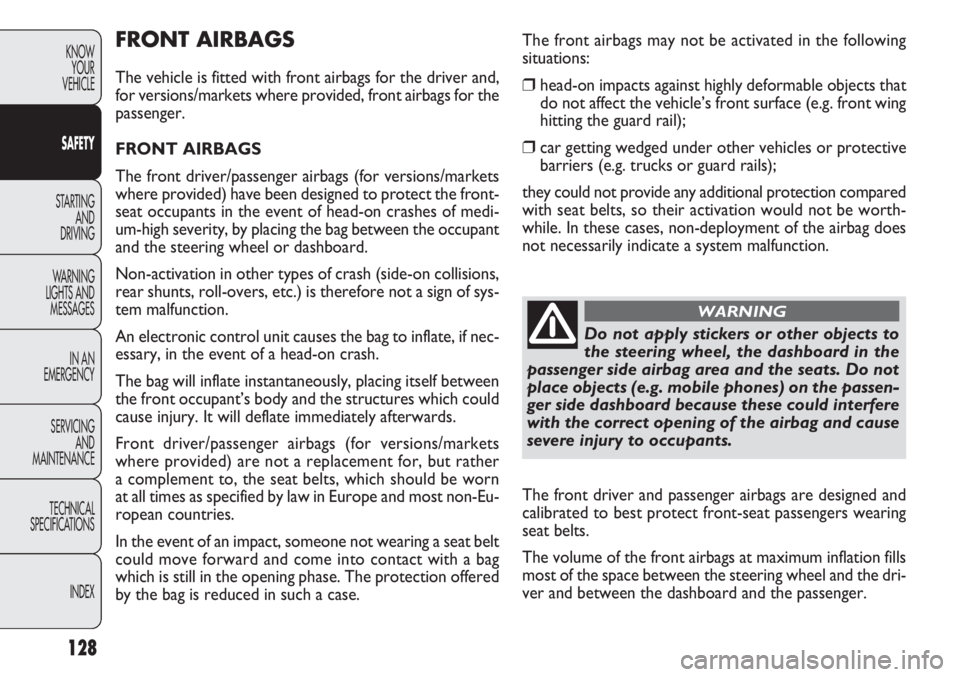
128
KNOWYOUR
VEHICLE
SAFETY
STARTING AND
DRIVING
W ARNING
LIGHTS AND MESSAGES
IN AN
EMERGENCY
SERVICING AND
MAINTENANCE
TECHNICAL
SPECIFICA
TIONSINDEX
FRONT AIRBAGS
The vehicle is fitted with front airbags for the driver and,
for versions/markets where provided, front airbags for the
passenger.
FRONT AIRBAGS
The front driver/passenger airbags (for versions/markets
where provided) have been designed to protect the front-
seat occupants in the event of head-on crashes of medi-
um-high severity, by placing the bag between the occupant
and the steering wheel or dashboard.
Non-activation in other types of crash (side-on collisions,
rear shunts, roll-overs, etc.) is therefore not a sign of sys-
tem malfunction.
An electronic control unit causes the bag to inflate, if nec-
essary, in the event of a head-on crash.
The bag will inflate instantaneously, placing itself between
the front occupant’s body and the structures which could
cause injury. It will deflate immediately afterwards.
Front driver/passenger airbags (for versions/markets
where provided) are not a replacement for, but rather
a complement to, the seat belts, which should be worn
at all times as specified by law in Europe and most non-Eu-
ropean countries.
In the event of an impact, someone not wearing a seat belt
could move forward and come into contact with a bag
which is still in the opening phase. The protection offered
by the bag is reduced in such a case. The front airbags may not be activated in the following
situations:❒head-on impacts against highly deformable objects that
do not affect the vehicle’s front surface (e.g. front wing
hitting the guard rail);
❒car getting wedged under other vehicles or protective
barriers (e.g. trucks or guard rails);
they could not provide any additional protection compared
with seat belts, so their activation would not be worth-
while. In these cases, non-deployment of the airbag does
not necessarily indicate a system malfunction.
Do not apply stickers or other objects to
the steering wheel, the dashboard in the
passenger side airbag area and the seats. Do not
place objects (e.g. mobile phones) on the passen-
ger side dashboard because these could interfere
with the correct opening of the airbag and cause
severe injury to occupants.
WARNING
The front driver and passenger airbags are designed and
calibrated to best protect front-seat passengers wearing
seat belts.
The volume of the front airbags at maximum inflation fills
most of the space between the steering wheel and the dri-
ver and between the dashboard and the passenger.
Page 133 of 283
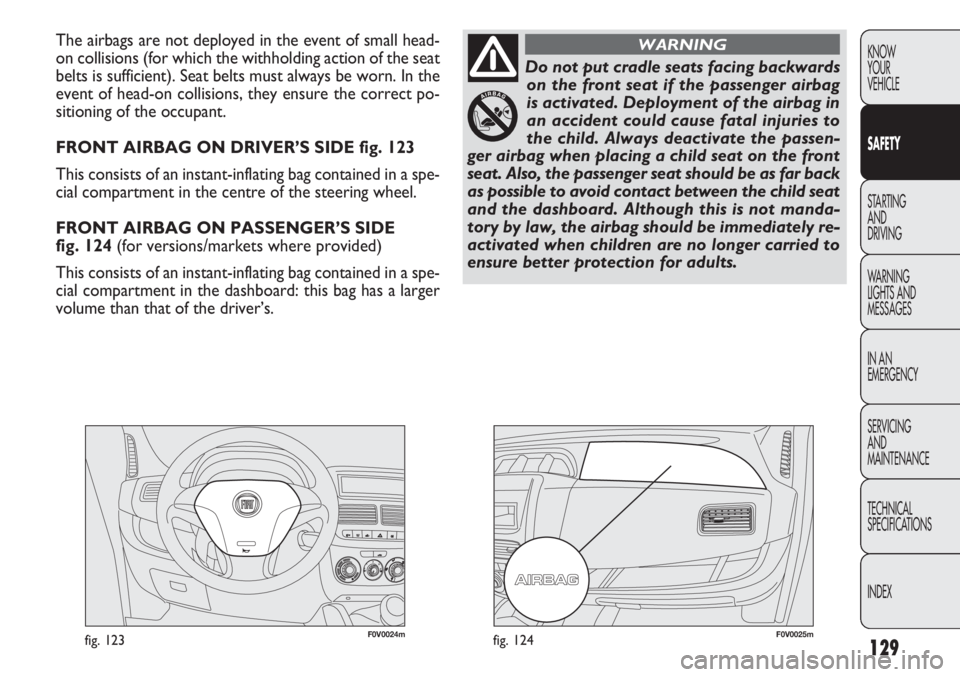
129
KNOW
YOUR
VEHICLE
SAFETY
STARTING
AND
DRIVING
WARNING
LIGHTS AND
MESSAGES
IN AN
EMERGENCY
SERVICING
AND
MAINTENANCE
TECHNICAL
SPECIFICATIONS
INDEX
F0V0024mfig. 123F0V0025mfig. 124
The airbags are not deployed in the event of small head-
on collisions (for which the withholding action of the seat
belts is sufficient). Seat belts must always be worn. In the
event of head-on collisions, they ensure the correct po-
sitioning of the occupant.
FRONT AIRBAG ON DRIVER’S SIDE fig. 123
This consists of an instant-inflating bag contained in a spe-
cial compartment in the centre of the steering wheel.
FRONT AIRBAG ON PASSENGER’S SIDE
fig. 124 (for versions/markets where provided)
This consists of an instant-inflating bag contained in a spe-
cial compartment in the dashboard: this bag has a larger
volume than that of the driver’s.
Do not put cradle seats facing backwardson the front seat if the passenger airbag
is activated. Deployment of the airbag in
an accident could cause fatal injuries to
the child. Always deactivate the passen-
ger airbag when placing a child seat on the front
seat. Also, the passenger seat should be as far back
as possible to avoid contact between the child seat
and the dashboard. Although this is not manda-
tory by law, the airbag should be immediately re-
activated when children are no longer carried to
ensure better protection for adults.
WARNING
Page 137 of 283
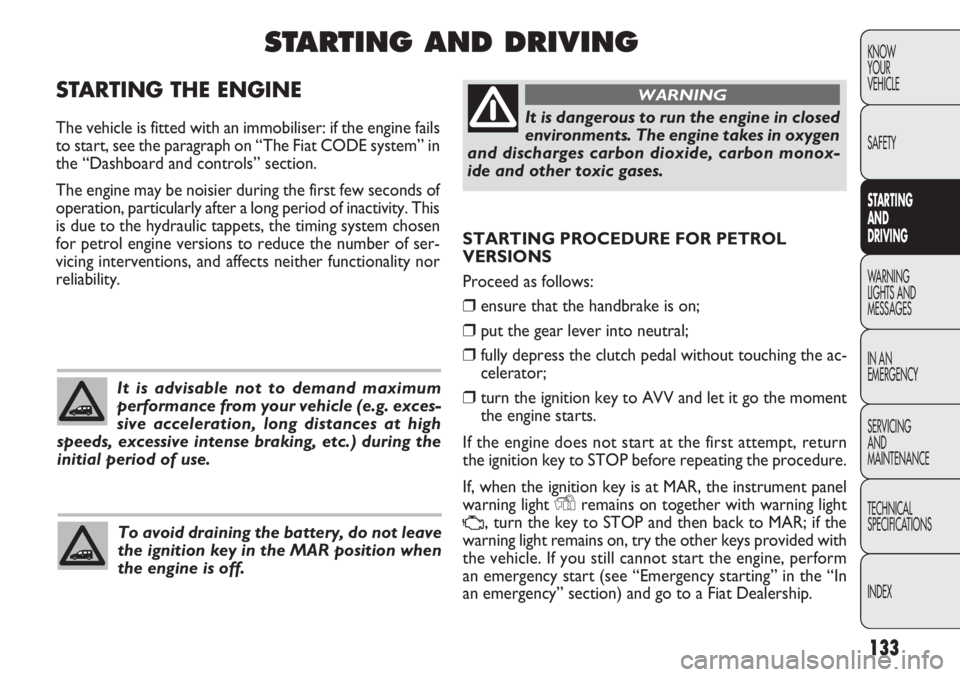
133
KNOW
YOUR
VEHICLE
SAFETY
STARTING
AN
D
DRIVING
WARNING
LIGHTS AND
MESSAGES
IN AN
EMERGENCY
SERVICING
AND
MAINTENANCE
TECHNICAL
SPECIFICA TIONS
INDEX
STARTING PROCEDURE FOR PETROL
VERSIONS
Proceed as follows:
❒ensure that the handbrake is on;
❒put the gear lever into neutral;
❒fully depress the clutch pedal without touching the ac-
celerator;
❒turn the ignition key to AVV and let it go the moment
the engine starts.
If the engine does not start at the first attempt, return
the ignition key to STOP before repeating the procedure.
If, when the ignition key is at MAR, the instrument panel
warning light
Yremains on together with warning light
U, turn the key to STOP and then back to MAR; if the
warning light remains on, try the other keys provided with
the vehicle. If you still cannot start the engine, perform
an emergency start (see “Emergency starting” in the “In
an emergency” section) and go to a Fiat Dealership.
STARTING THE ENGINE
The vehicle is fitted with an immobiliser: if the engine fails
to start, see the paragraph on “The Fiat CODE system” in
the “Dashboard and controls” section.
The engine may be noisier during the first few seconds of
operation, particularly after a long period of inactivity. This
is due to the hydraulic tappets, the timing system chosen
for petrol engine versions to reduce the number of ser-
vicing interventions, and affects neither functionality nor
reliability.
STARTING AND DRIVING
It is advisable not to demand maximum
performance from your vehicle (e.g. exces-
sive acceleration, long distances at high
speeds, excessive intense braking, etc.) during the
initial period of use.
To avoid draining the battery, do not leave
the ignition key in the MAR position when
the engine is off.
It is dangerous to run the engine in closed
environments. The engine takes in oxygen
and discharges carbon dioxide, carbon monox-
ide and other toxic gases.
WARNING
Page 146 of 283
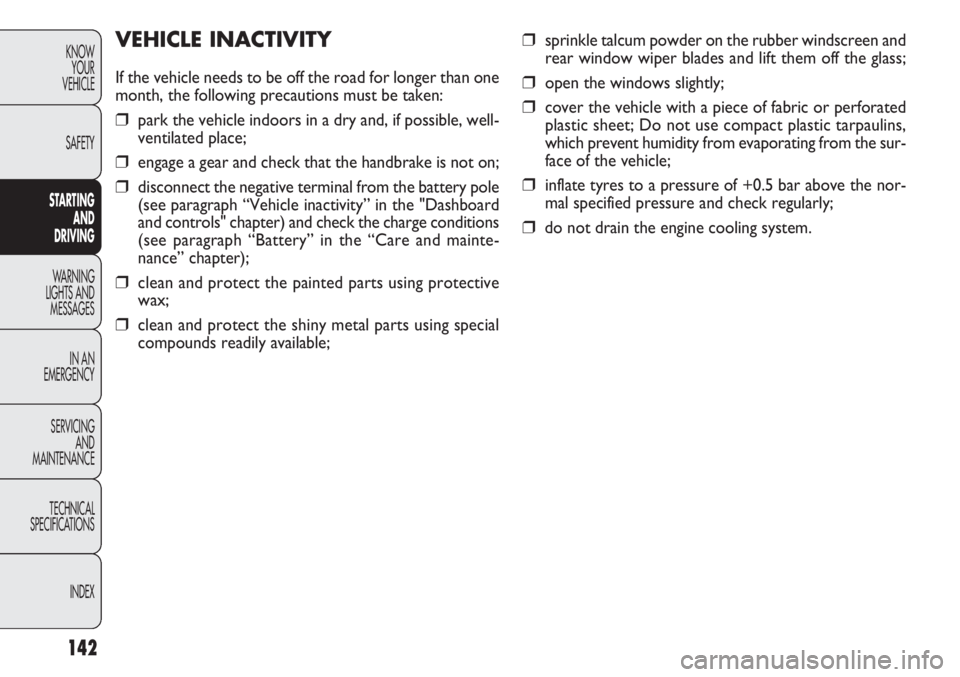
142
KNOWYOUR
VEHICLE
SAFETY
ST ARTING
AN
D
DRIVING
WARNING
LIGHTS AND MESSAGES
IN AN
EMERGENCY
SERVICING AND
MAINTENANCE
TECHNICAL
SPECIFICA TIONS
INDEX
❒sprinkle talcum powder on the rubber windscreen and
rear window wiper blades and lift them off the glass;
❒open the windows slightly;
❒cover the vehicle with a piece of fabric or perforated
plastic sheet; Do not use compact plastic tarpaulins,
which prevent humidity from evaporating from the sur-
face of the vehicle;
❒inflate tyres to a pressure of +0.5 bar above the nor-
mal specified pressure and check regularly;
❒do not drain the engine cooling system.
VEHICLE INACTIVITY
If the vehicle needs to be off the road for longer than one
month, the following precautions must be taken:
❒park the vehicle indoors in a dry and, if possible, well-
ventilated place;
❒engage a gear and check that the handbrake is not on;
❒disconnect the negative terminal from the battery pole
(see paragraph “Vehicle inactivity” in the "Dashboard
and controls" chapter) and check the charge conditions
(see paragraph “Battery” in the “Care and mainte-
nance” chapter);
❒clean and protect the painted parts using protective
wax;
❒clean and protect the shiny metal parts using special
compounds readily available;
Page 153 of 283
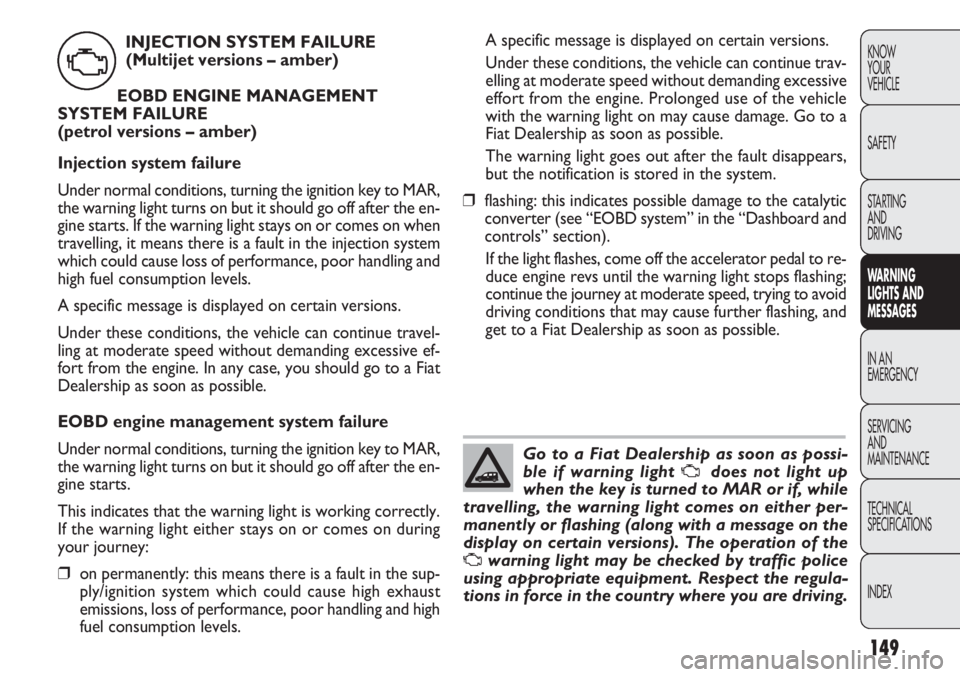
149
KNOW
YOUR
VEHICLE
SAFETY
STARTING
AND
DRIVING
WA R N I NG
LIGHTS AND
MESSAGES
IN AN
EMERGENCY
SERVICING
AND
MAINTENANCE
TECHNICAL
SPECIFICA TIONS
INDEXA specific message is displayed on certain versions.
Under these conditions, the vehicle can continue trav-
elling at moderate speed without demanding excessive
effort from the engine. Prolonged use of the vehicle
with the warning light on may cause damage. Go to a
Fiat Dealership as soon as possible.
The warning light goes out after the fault disappears,
but the notification is stored in the system.
❒ flashing: this indicates possible damage to the catalytic
converter (see “EOBD system” in the “Dashboard and
controls” section).
If the light flashes, come off the accelerator pedal to re-
duce engine revs until the warning light stops flashing;
continue the journey at moderate speed, trying to avoid
driving conditions that may cause further flashing, and
get to a Fiat Dealership as soon as possible.
INJECTION SYSTEM FAILURE
(Multijet versions – amber)
EOBD ENGINE MANAGEMENT
SYSTEM FAILURE
(petrol versions – amber)
Injection system failure
Under normal conditions, turning the ignition key to MAR,
the warning light turns on but it should go off after the en-
gine starts. If the warning light stays on or comes on when
travelling, it means there is a fault in the injection system
which could cause loss of performance, poor handling and
high fuel consumption levels.
A specific message is displayed on certain versions.
Under these conditions, the vehicle can continue travel-
ling at moderate speed without demanding excessive ef-
fort from the engine. In any case, you should go to a Fiat
Dealership as soon as possible.
EOBD engine management system failure
Under normal conditions, turning the ignition key to MAR,
the warning light turns on but it should go off after the en-
gine starts.
This indicates that the warning light is working correctly.
If the warning light either stays on or comes on during
your journey:
❒ on permanently: this means there is a fault in the sup-
ply/ignition system which could cause high exhaust
emissions, loss of performance, poor handling and high
fuel consumption levels.
U
Go to a Fiat Dealership as soon as possi-
ble if warning light
Udoes not light up
when the key is turned to MAR or if, while
travelling, the warning light comes on either per-
manently or flashing (along with a message on the
display on certain versions). The operation of the
Uwarning light may be checked by traffic police
using appropriate equipment. Respect the regula-
tions in force in the country where you are driving.
Page 157 of 283
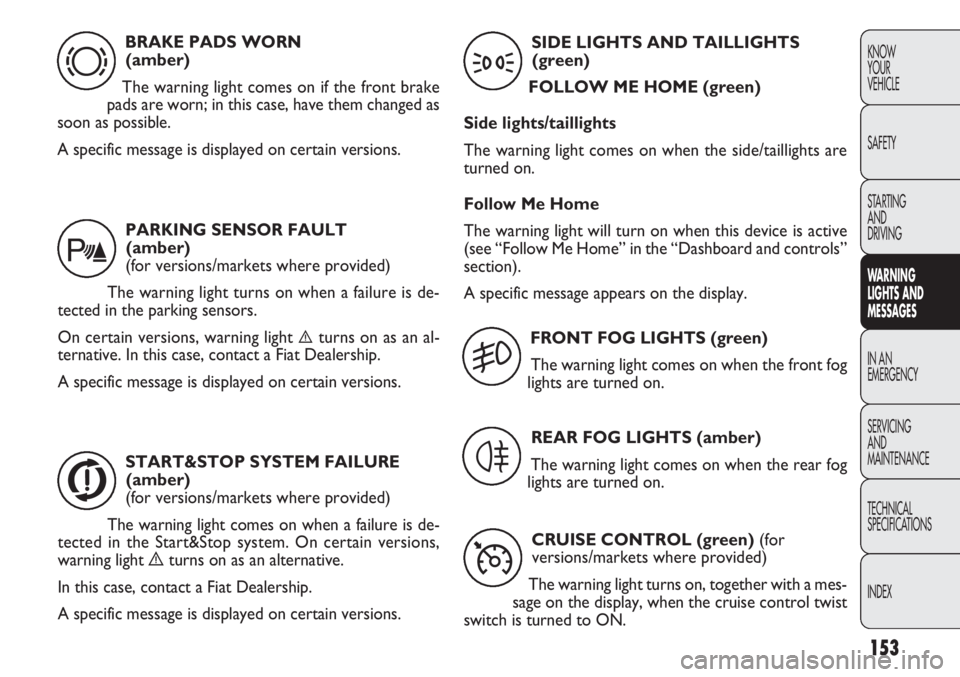
153
KNOW
YOUR
VEHICLE
SAFETY
STARTING
AND
DRIVING
WA R N I NG
LIGHTS AND
MESSAGES
IN AN
EMERGENCY
SERVICING
AND
MAINTENANCE
TECHNICAL
SPECIFICA TIONS
INDEXBRAKE PADS WORN (amber)
The warning light comes on if the front brake
pads are worn; in this case, have them changed as
soon as possible.
A specific message is displayed on certain versions.
d
PARKING SENSOR FAULT (amber)
(for versions/markets where provided)
The warning light turns on when a failure is de-
tected in the parking sensors.
On certain versions, warning light
èturns on as an al-
ternative. In this case, contact a Fiat Dealership.
A specific message is displayed on certain versions.
t
START&STOP SYSTEM FAILURE (amber)
(for versions/markets where provided)
The warning light comes on when a failure is de-
tected in the Start&Stop system. On certain versions,
warning light èturns on as an alternative.
In this case, contact a Fiat Dealership.
A specific message is displayed on certain versions.
j
SIDE LIGHTS AND TAILLIGHTS (green)
FOLLOW ME HOME (green)
Side lights/taillights
The warning light comes on when the side/taillights are
turned on.
Follow Me Home
The warning light will turn on when this device is active
(see “Follow Me Home” in the “Dashboard and controls”
section).
A specific message appears on the display.
3
FRONT FOG LIGHTS (green) The warning light comes on when the front fog
lights are turned on.
5
REAR FOG LIGHTS (amber)
The warning light comes on when the rear fog
lights are turned on.
4
CRUISE CONTROL (green) (for versions/markets where provided)
The warning light turns on, together with a mes-
sage on the display, when the cruise control twist
switch is turned to ON.
Ü
Page 167 of 283
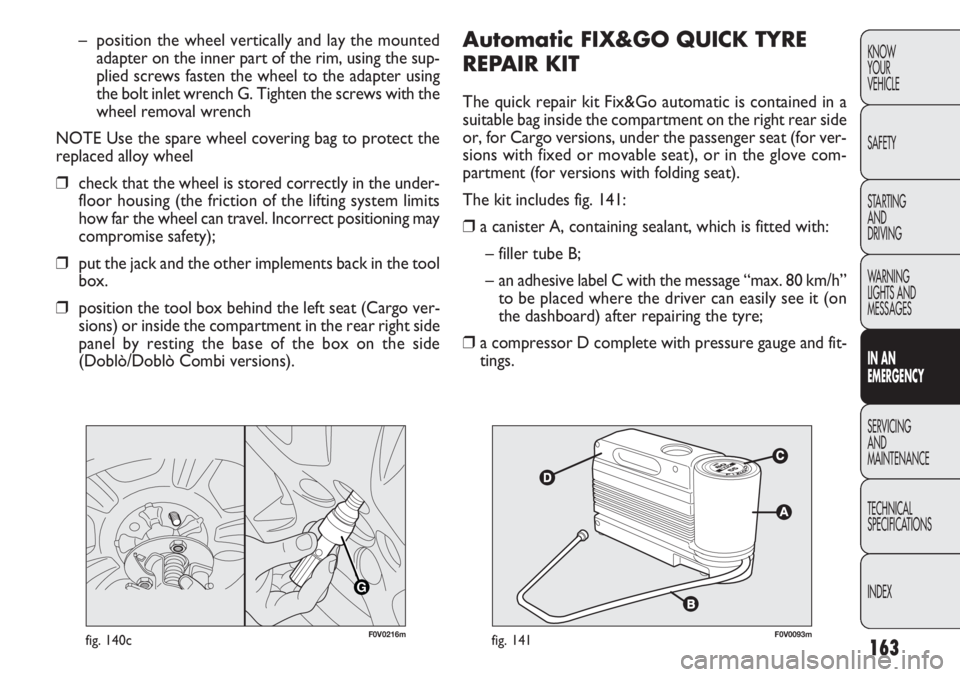
163
KNOW
YOUR
VEHICLE
SAFETY
STARTING
AND
DRIVING
WARNING
LIGHTS AND
MESSAGES
IN AN
EMERGENCY
SERVICING
AND
MAINTENANCE
TECHNICAL
SPECIFICATIONS
INDEXAutomatic FIX&GO QUICK TYRE
REPA I R KIT
The quick repair kit Fix&Go automatic is contained in a
suitable bag inside the compartment on the right rear side
or, for Cargo versions, under the passenger seat (for ver-
sions with fixed or movable seat), or in the glove com-
partment (for versions with folding seat).
The kit includes fig. 141:
❒a canister A, containing sealant, which is fitted with:
– filler tube B;
– an adhesive label C with the message “max. 80 km/h” to be placed where the driver can easily see it (on
the dashboard) after repairing the tyre;
❒ a compressor D complete with pressure gauge and fit-
tings.
– position the wheel vertically and lay the mounted
adapter on the inner part of the rim, using the sup-
plied screws fasten the wheel to the adapter using
the bolt inlet wrench G. Tighten the screws with the
wheel removal wrench
NOTE Use the spare wheel covering bag to protect the
replaced alloy wheel
❒ check that the wheel is stored correctly in the under-
floor housing (the friction of the lifting system limits
how far the wheel can travel. Incorrect positioning may
compromise safety);
❒ put the jack and the other implements back in the tool
box.
❒ position the tool box behind the left seat (Cargo ver-
sions) or inside the compartment in the rear right side
panel by resting the base of the box on the side
(Doblò/Doblò Combi versions).
G
F0V0216mfig. 140cF0V0093mfig. 141
Page 273 of 283
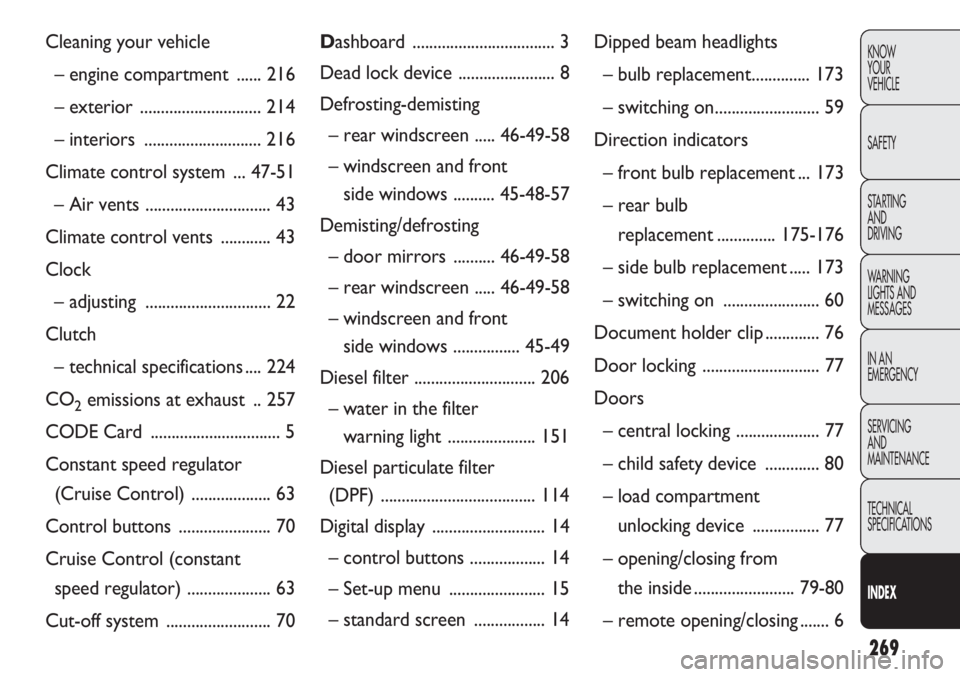
269
KNOW
YOUR
VEHICLE
SAFETY
STARTING
AND
DRIVING
WARNING
LIGHTS AND
MESSAGES
IN AN
EMERGENCY
SERVICING
AND
MAINTENANCE
TECHNICAL
SPECIFICATIONS
INDEXDashboard .................................. 3
Dead lock device ....................... 8
Defrosting-demisting – rear windscreen ..... 46-49-58
– windscreen and front side windows .......... 45-48-57
Demisting/defrosting – door mirro rs ..........46-49-58
– rear windscreen ..... 46-49-58
– windscreen and front side windows ................ 45-49
Diesel filter ............................. 206
– water in the filter warning light ..................... 151
Diesel particulate filter (DPF) ..................................... 114
Digital di splay ........................... 14
– control buttons .................. 14
– Set-up menu ....................... 15
– standard screen ................. 14Dipped beam headlights
– bulb replace ment.............. 173
– switching on......................... 59
Direction indicators – front bulb replacement ... 173
– rear bulb replacement ..............175-176
– side bulb replacement ..... 173
– switching on ....................... 60
Document holder clip ............. 76
Door lock ing ............................ 77
Doors – central locking .................... 77
– child safety device ............. 80
– load compartment unlocking device ................ 77
– opening/closing from the inside ........................ 79-80
– remote opening/closing ....... 6
Cleaning your vehicle
– engine compartment ...... 216
– exterior ............................. 214
– interio rs ............................ 216
Climate control system ... 47-51 – Air vents .............................. 43
Climate control vents ............ 43
Clock – adjusting .............................. 22
Clutch – technical specifications .... 224
CO
2emissions at exhaust .. 257
CODE Card ............................... 5
Constant speed regulator (Cruise Control) ................... 63
Control buttons ...................... 70
Cruise Control (constant speed regulator) .................... 63
Cut-off system ......................... 70